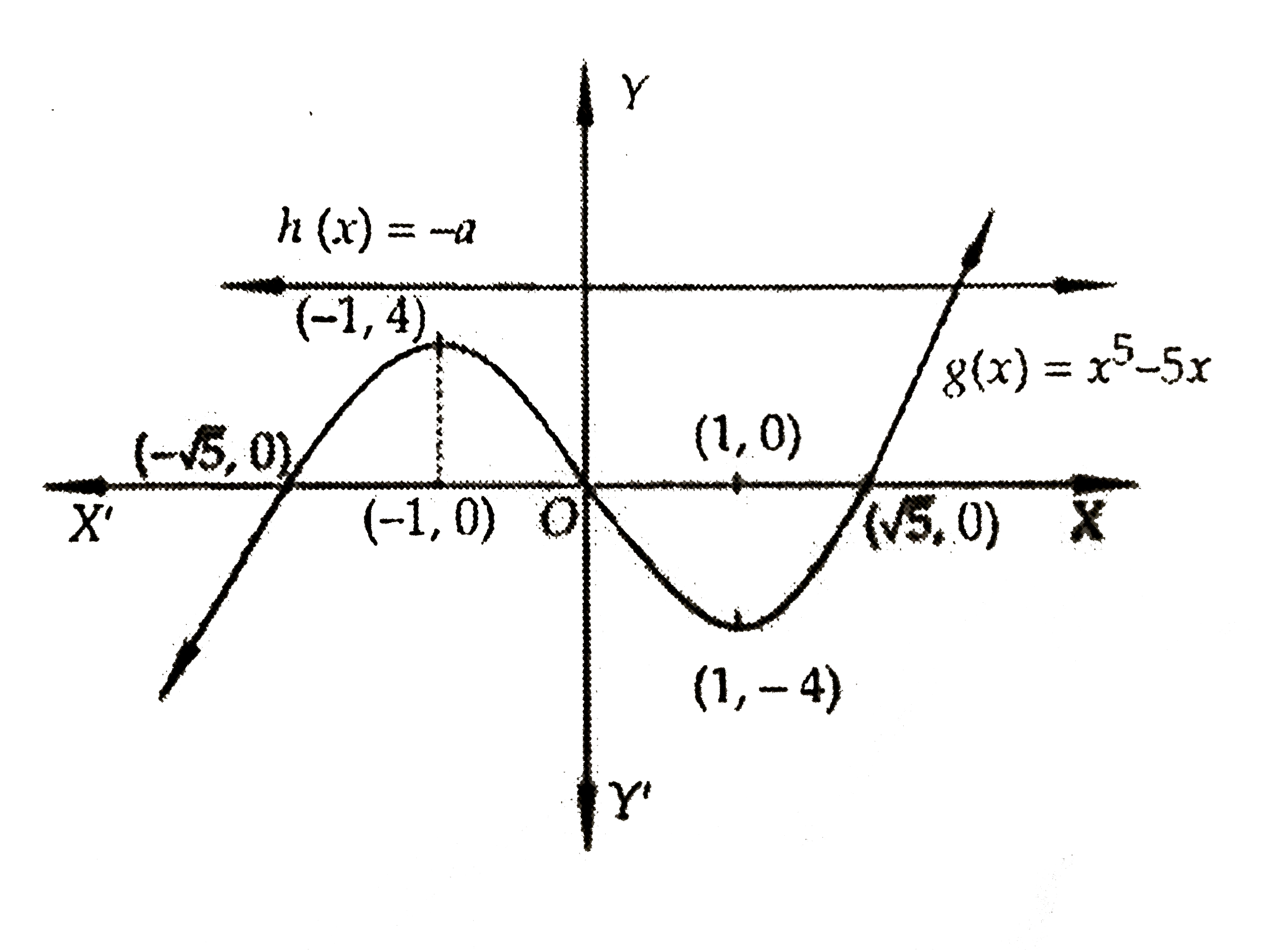Let a ∈ R and f : R→R be given by f(x)=x5−5x+a, then
(a) f(x)=0 has three real roots if a>4
(b) f(x)=0 has only one real root if a>4
(c) f(x)=0 has three real roots if a<−4
(d) f(x)=0 has three real roots if −4<a<4
f(x) has three real roots if a>4
f(x) has only one real root if a>4
f(x) has three real roots if a<−4
f(x) has three real roots if −4<a<4
The correct Answer is:B, D
Let g(x)x5−5x and h(x)=-a. Then, the number of real roots of f(x)=0 is the number of points of intersection of the curves y=g(x) and y=h(x). Clearly, these two curves intersect at three points, if −4<a<4.

So, f(x) has three real roots, if 4<a<4.
The two curves y=g(x) and y=h(x) intersect at exactly one point if a>4 or a<−4.
So, f(x) has only one real root if a<−4 or a>4.
Topper's Solved these Questions
- MISCELLANEOUS EQUATIONS AND INEQUATIONS BOOK - OBJECTIVE RD SHARMA ENGLISHCHAPTER - MISCELLANEOUS EQUATIONS AND INEQUATIONS EXERCISE - Exercise
30 Videos
- MISCELLANEOUS EQUATIONS AND INEQUATIONS BOOK - OBJECTIVE RD SHARMA ENGLISHCHAPTER - MISCELLANEOUS EQUATIONS AND INEQUATIONS EXERCISE - Chapter Test
29 Videos
- MEASURES OF CENTRAL TENDENCYBOOK - OBJECTIVE RD SHARMA ENGLISHCHAPTER - MEASURES OF CENTRAL TENDENCYEXERCISE - Chapter Test
21 Videos
- PLANE AND STRAIGHT LINE IN SPACE BOOK - OBJECTIVE RD SHARMA ENGLISHCHAPTER - PLANE AND STRAIGHT LINE IN SPACE EXERCISE - Chapter Test
31 Videos
Similar Questions
Let a∈R and let f:R→ be given by f(x)=x5−5x+a, then (a) f(x) has three real roots if a>4 (b)f(x) has only one real roots if a>4 (c)f(x) has three real roots if a<−4 (d)f(x) has three real roots if −4<a<4
View SolutionIf the equaion x2+ax+b=0 has distinct real roots and x2+a|x|+b=0 has only one real root, then
View SolutionIf x2+bx+x=0 has no real roots and a+b+c<0 then
View SolutionFind the value of such that x3−|a|x2+3x+4=0 has only one real root.
View SolutionGiven that ax2+bx+c=0 has no real roots and a+b+c<0, then c≠0 b. c<0 c. c>0 d. c=0
View SolutionGiven that ax2+bx+c=0 has no real roots and a+b+c<0, then c≠0 b. c<0 c. c>0 d. c=0
View SolutionLet f(x)=3x−2+4x−3+5x−4. Then f(x)=0 has (A) exactly one real root in (2,3) (B) exactly one real root in (3,4) (C) at least one real root in (2,3) (D) none of these
View SolutionA particle is moving along x-direction with a constant acceleration a. The particle starts from x=x0 position with initial velocity u. We can define the position of the particle with time by the relation
x=x0+ut+12at2
plot the position of the particle in relation with time is following situations
(i) If initial position of the particle is on negativ x-axis, initial velocity is positive and acceleration is negative.
(ii) If initial position is positive, initial velocity is negative and acceleration is positive.
View SolutionIf the equation x3+px+q=0 has three real roots then show that 4p3+27q2<0.
View SolutionIf f(x)=ax2+bx+c,g(x)=−ax2+bx+c ,where ac≠0, then prove that f(x)g(x)=0 has at least two real roots.
View Solution
